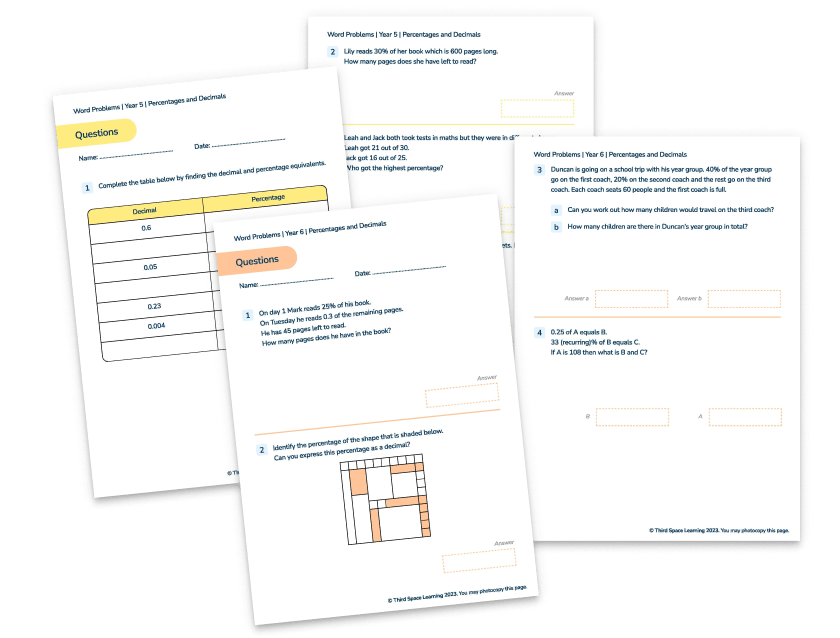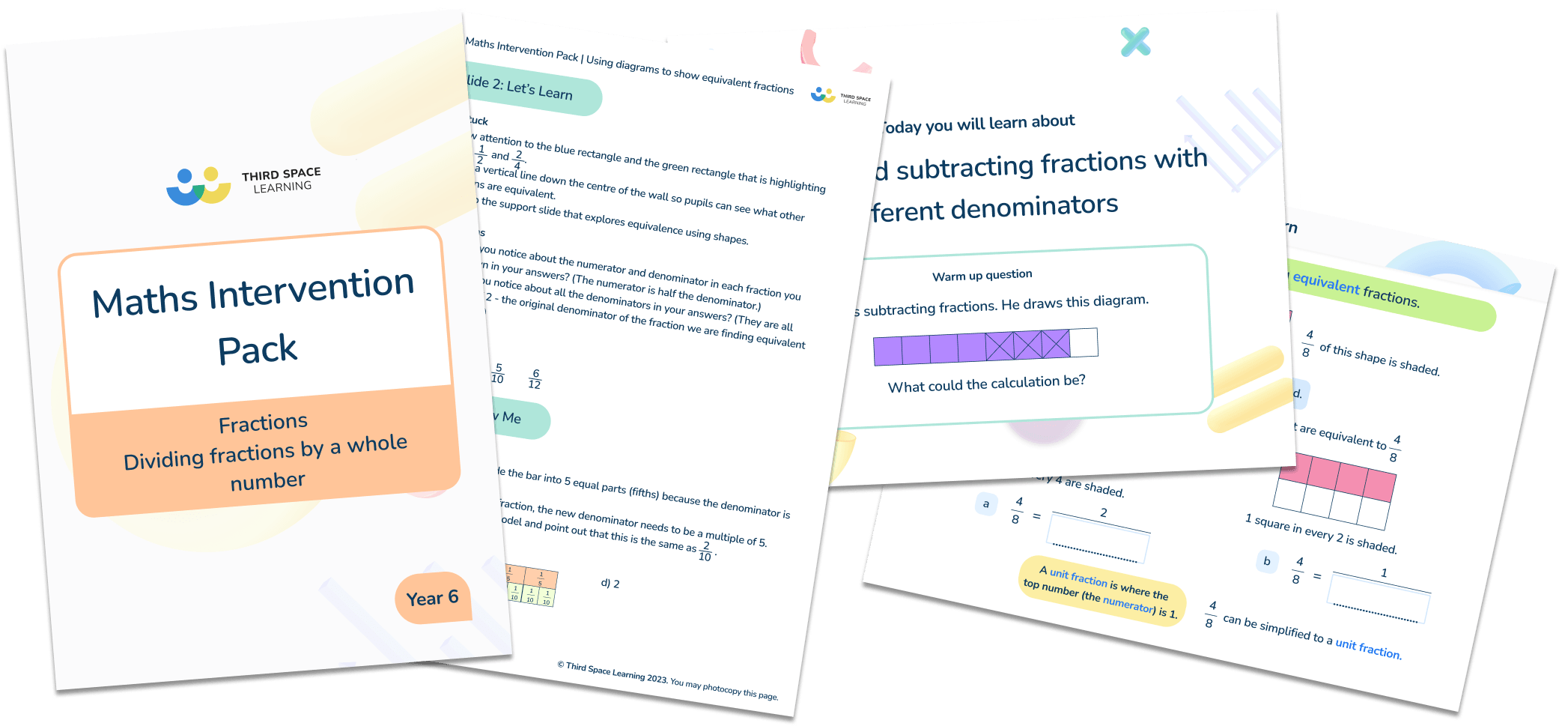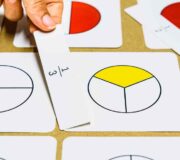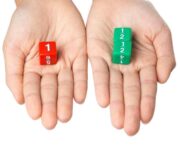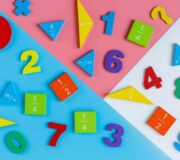Subtracting Fractions: Step By Step Guide
Pupils are introduced to fractions from KS1 but won’t usually be taught about subtracting fractions until KS2. This can be quite a complex procedure, especially with fractions that have different denominators.
Here you’ll find our step-by-step guide on subtracting fractions, including worked examples, practice problems, and fraction questions. These will assist you when teaching KS2 fractions, so you can apply this to interlinking topics that involve comparing fractions, decimals, and percentages.
- What are fractions?
- Subtracting fractions: what does it mean?
- When do pupils learn about subtracting fractions?
- How to subtract fractions
- Subtracting fractions with the same denominator
- Subtracting fractions with different denominators
- Subtracting mixed numbers
- Subtracting fractions: worked examples
- Subtracting fractions: practice questions
- Frequently asked questions
What are fractions?
A fraction is a part of a whole. Fractions are made up of a numerator and denominator which are separated by a line (called a vinculum) representing a division symbol – this is because a fraction is essentially a division. For example, \frac{1}{2} is the same as 1 ÷ 2 , and of course 1 ÷ 2 = \frac{1}{2} .
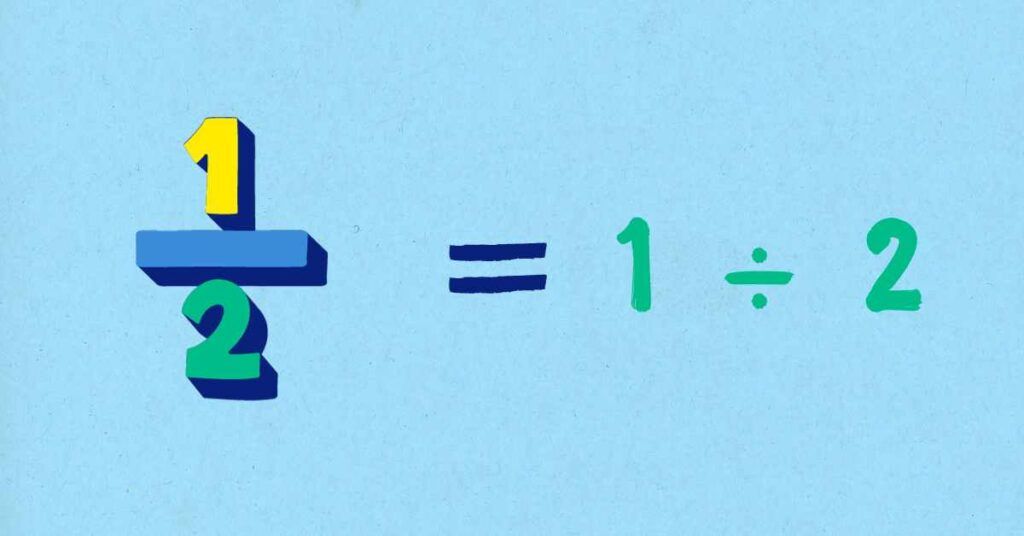
Download Fractions Intervention Pack
Download these fractions interventions packs to help your students feel confident on fractions.
Download Free Now!Once pupils understand the basics, such as how to simplify fractions, they can start applying this to adding and subtracting fractions.
Subtracting fractions: what does it mean?
Just like subtracting integers, subtraction of fractions involves finding the difference between two fractions.
When do pupils learn about subtracting fractions?
Pupils aren’t expected to subtract fractions until key stage 2. In years 3 and 4, pupils learn to subtract fractions with the same denominator. In years 5 and 6, pupils learn to subtract fractions with different denominators. In these year groups, pupils will then begin to learn how to multiply fractions and how to divide fractions.
The national curriculum states that pupils should be taught to:
- In year 3: add and subtract fractions with the same denominator within one whole [for example, \frac{5}{7} + \frac{1}{7} = \frac{6}{7} ].
- In year 4: add and subtract fractions with the same denominator.
- In year 5: add and subtract fractions with the same denominator and denominators that are multiples of the same number.
- In year 6, add and subtract fractions with different denominators and mixed numbers, using the concept of equivalent fractions.

Unlimited primary maths tutoring with Skye, the voice-based AI maths tutor.
Built on the same principles, pedagogy and curriculum as our traditional tutoring but with more flexibility, reach and lower cost.
Join the schools already helping hundreds of primary pupils nationwide with Skye’s one to one maths tutoring
Watch Skye in actionHow to subtract fractions
To subtract fractions, follow these steps:
- Find a common denominator: Ensure the bottom numbers (denominators) are the same.
- Subtract the numerators: Once the denominators are the same, subtract the top numbers (numerators).
- Put the answer over the common denominator: Place the new numerator over the common denominator.
- Simplify if possible: If possible, simplify the answer.
Examples
- \frac{11}{12} - \frac{3}{4} =
- \frac{11}{12} - \frac{9}{12} = \frac{2}{12}
- \frac{2}{12} = \frac{1}{6}
Subtracting fractions with the same denominator
To introduce pupils to subtracting fractions in lower key stage 2, pupils are first taught to subtract fractions with the same denominator, or ‘like denominators’. This is because they then need only calculate with the numerators (when the denominators are the same, it means the fraction sizes are the same).
When the denominators of two fractions are the same, we can add and subtract them from each other as parts of a whole.

Using these diagrams, we can see that:
- \frac{3}{8} + \frac{2}{8} = \frac{5}{8}
- \frac{2}{8} + \frac{3}{8} = \frac{5}{8}
- \frac{5}{8} - \frac{2}{8} = \frac{3}{8}
- \frac{5}{8} + \frac{3}{8} = \frac{2}{8}
It may be helpful to write these number sentences on the board with the denominators as words and the numerators as digits, to avoid the misconception that the denominators need subtracting as well: for example, “5 eighths - 2 eighths = 3 eighths”, etc.
Read more: 28 Fraction Word Problems
Subtracting fractions with different denominators
In upper key stage 2, pupils are taught to subtract fractions with different denominators, or ‘unlike denominators’: fractions with different denominators are often called unlike fractions.
This is firstly taught using fractions with related denominators (where both denominators are multiples of the same number). Then, in year 6, they are taught with unrelated denominators.
When going through the process of how to add fractions or how to subtract fractions, the denominators need to be the same. Let’s look at a pair of fractions where one denominator is a multiple of another. Using diagrams, we can subtract the fractions.
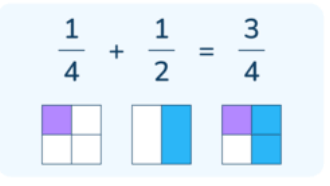
Without diagrams, we can subtract them by finding a common denominator (a common denominator is when two or more fractions have the same denominator). To find a common denominator, we need to find the lowest common multiple (LCM) of the denominators (any common multiple will work, but the LCM is more efficient). We should then find equivalent fractions with this new denominator.
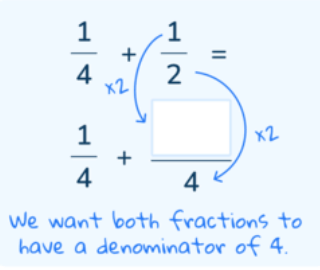
\frac{1}{2} is equivalent to \frac{2}{4} , so we can now subtract the numerators: \frac{3}{4} - \frac{2}{4} = \frac{1}{4}
This is an example of subtracting related fractions because 4 and 2 are multiples of the same number. To subtract unrelated fractions, the method is the same.
Let’s try \frac{4}{5} - \frac{3}{4} .
- Find a common denominator: the LCM of 5 and 4 is 20
- Find equivalent fractions using the new denominator: \frac{4}{5} = \frac{16}{20} and \frac{3}{4} = \frac{15}{20}
- Subtract the numerators: \frac{16}{20} - \frac{15}{20} = \frac{1}{20}
Subtracting mixed numbers
You can subtract mixed numbers by subtracting the integers and subtracting the fractions. This can be done by partitioning the mixed numbers into whole numbers and fractions, subtracting the fractions and subtracting the whole numbers.
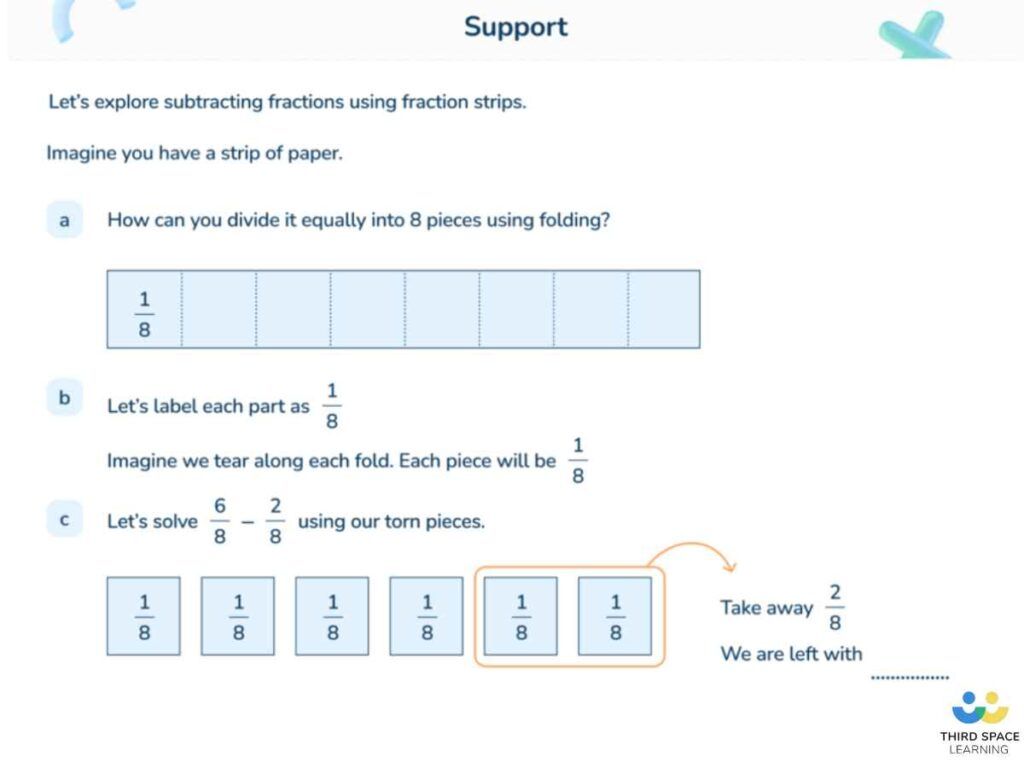
For example, with 2 \frac{3}{5} - 1 \frac{1}{3}
- Partition the mixed numbers: (2 + \frac{3}{5}) - (1 + \frac{1}{3})
- Find a common denominator for the fractions: the LCM of 5 and 3 is 15
- Find equivalent fractions using the new denominator: \frac{3}{5} = \frac{9}{15} and \frac{1}{3} = \frac {5}{15}
- Subtract the numerators: \frac{9}{15} - \frac{5}{15} = \frac {4}{15}
- Subtract whole numbers and recombine the parts: 2 - 1 = 1 , 1 + \frac{4}{15} = 1 \frac{4}{15}
Sometimes, the fractions might break the whole when subtracted - in this case, we can convert the mixed numbers to improper fractions to help. For example, 2 \frac{1}{4} - 1 \frac{2}{3} : we can’t subtract the fractions alone as it would result in a negative answer.
- Convert to improper fractions: \frac{9}{4} - \frac{5}{3}
- Find a common denominator for the fractions: the LCM of 4 and 3 is 12
- Find equivalent fractions using the new denominator: \frac{9}{4} = \frac{27}{12} and \frac{5}{3} = \frac{20}{12}
- Subtract the numerators: \frac{27}{12} - \frac{20}{12} = \frac{7}{12}
- Convert back to mixed numbers and/or simplify (if either is necessary - not in this case).
Read more:
- 10 Simple, Fun Fractions Games for KS1 and KS2
- What Is A Unit Fraction: Explained For Primary School
- What Is An Improper Fraction: Explained For Primary School
- How To Explain KS2 Fractions
- How to Teach KS2 Fractions: Maths Bootcamp
Subtracting fractions: worked examples
- Write the missing fraction to make this addition correct: \frac{2}{3} + ? = \frac{5}{6}
In missing number addition problems, we need to use the inverse (subtraction) to find the missing number - so, in this case, \frac{5}{6} - \frac{2}{3} .
1. Find a common denominator: the LCM of 6 and 3 is 6
2. Find equivalent fractions using the new denominator: the first fraction can stay the same as it’s already in sixths, and \frac{2}{3} = \frac{4}{6}
3. Subtract the numerators: \frac{5}{6} - \frac{4}{6} = \frac{1}{6}
Therefore, the missing fraction is \frac{1}{6} .
- 2\frac{1}{3} - \frac{5}{7} = ?
1. Convert to improper fractions (as partitioning and then subtracting the fractions would break the whole): 2 \frac{1}{3} = \frac{7}{3}
2. Find a common denominator for the fractions: the LCM of 3 and 7 is 21
3. Find equivalent fractions using the new denominator: \frac{7}{3} = \frac{49}{21} and \frac{5}{7} = \frac{15}{21}
4. Subtract the numerators: \frac{49}{21} - \frac{15}{21} = \frac{34}{21}
5. Convert back to mixed numbers and/or simplify (if either is necessary): the correct answer is 1 \frac{13}{21}
- A family shares 2 pizzas. The parents eat \frac{4}{5} of a pizza and the pupils eat \frac{5}{6} of a pizza. How much pizza is left?
We could either calculate the total of \frac{4}{5} and \frac{5}{6} and then subtract it from 2, or subtract each fraction from 2 separately (2 - \frac{4}{5} - \frac{5}{6} ). Adding the fractions first gives the total of \frac{49}{30} , which we now need to subtract from 2:
1. Convert to improper fractions (as partitioning and then subtracting the fractions would break the whole): 2 = \frac{2}{1}
2. Find a common denominator for the fractions: the LCM of 1 and 30 is 30
3. Find equivalent fractions using the new denominator: \frac{2}{1} = \frac{60}{30} , and the denominator of the second fraction is already 30
4. Subtract the numerators: \frac{60}{30} - \frac{49}{30} = \frac{11}{30}
5. Convert back to mixed numbers and/or simplify (if either is necessary): neither is possible here, so we have a final answer of \frac{7}{10} of the pizza.
Subtracting fractions: practice questions
- James cuts a cake into ten equal pieces. He eats one piece. What fraction of the cake is left?
Answer: \frac{9}{10} of the cake
- 1 - \frac{1}{5} - \frac{1}{3}
Answer: \frac{7}{15}
- Write the missing fraction to make this addition correct: 1 \frac{3}{4} = \frac{7}{8} + ?
Answer: \frac{7}{8}
- \frac{9}{10} - \frac{2}{5}
Answer: \frac{5}{10} (or \frac{1}{2} in the simplest form)
- Bill’s car has half a tank of petrol in it. He takes it on a journey that uses up another \frac{2}{7} of the tank of petrol. What fraction of the tank of petrol is left?
Answer: \frac{3}{14} of the tank of petrol
Frequently asked questions
If the denominators (the bottom numbers) are the same, just subtract the numerators (the top numbers). For example, \frac{7}{8} - \frac{1}{8} = \frac{6}{8} . If the denominators are different:
1) Find a common denominator by working out the lowest common multiple.
2) Find equivalent fractions using the new denominator
3) Subtract the numerators.
For example, with \frac{4}{5} - \frac{2}{3} :
1) Find a common denominator: the LCM of 5 and 3 is 15
2) Find equivalent fractions using the new denominator: \frac{4}{5} = \frac{12}{15} and \frac{2}{3} = \frac{10}{15}
3) Subtract the numerators: \frac{12}{15} - \frac{10}{15} = \frac{2}{15}
In this case, you need to find a common denominator. This can be done by working out the Lowest Common Multiple of each denominator. You can then find equivalent fractions using the new denominator and finally subtract the numerators.
DO YOU HAVE STUDENTS WHO NEED MORE SUPPORT IN MATHS?
Skye – our AI maths tutor built by teachers – gives students personalised one-to-one lessons that address learning gaps and build confidence.
Since 2013 we’ve taught over 2 million hours of maths lessons to more than 170,000 students to help them become fluent, able mathematicians.
Explore our AI maths tutoring or find out about a primary school maths tutor for your school.
